Page 3879 of 5267
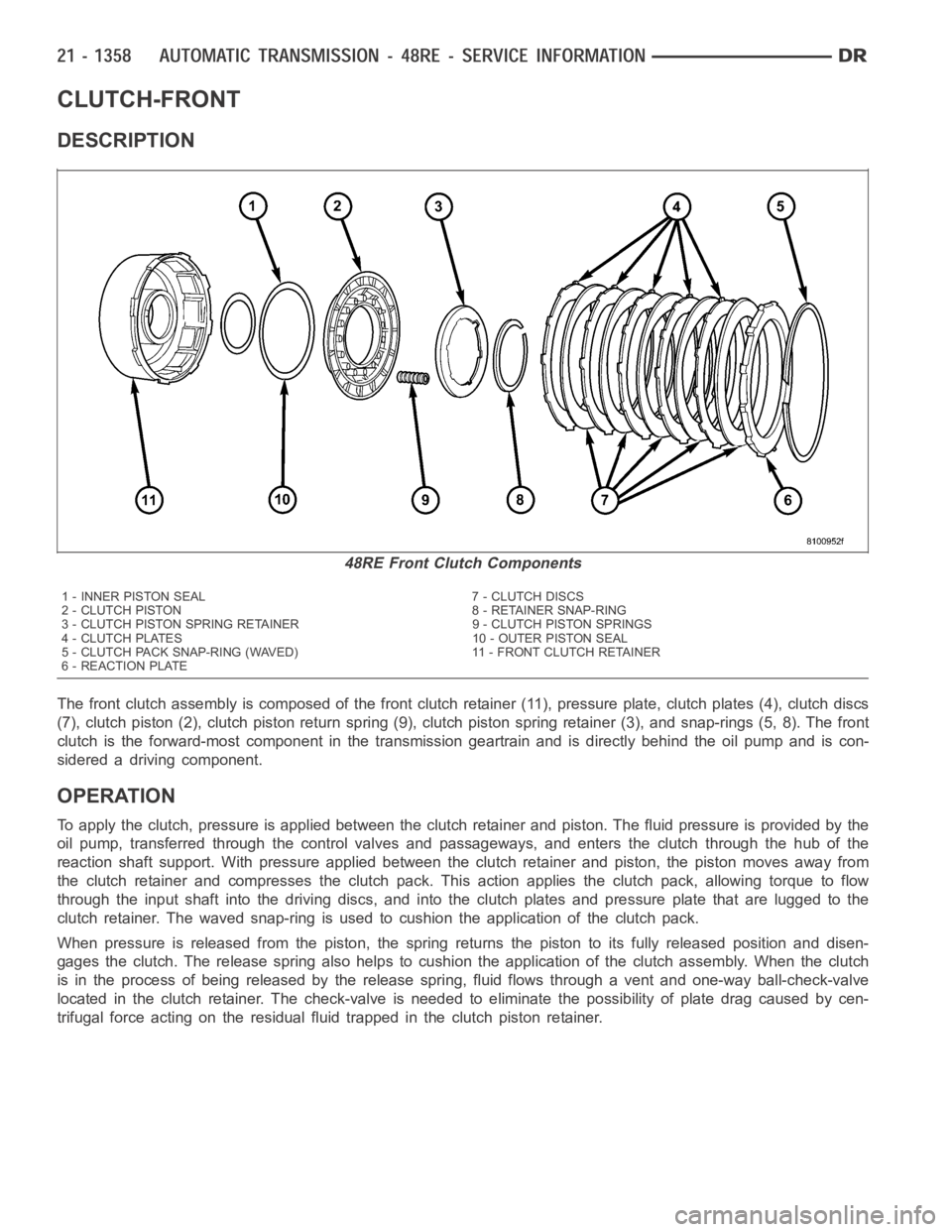
CLUTCH-FRONT
DESCRIPTION
The front clutch assembly is composed of the front clutch retainer (11), pressure plate, clutch plates (4), clutch discs
(7), clutch piston (2), clutch piston return spring (9), clutch piston spring retainer (3), and snap-rings (5, 8). The front
clutch is the forward-most component in the transmission geartrain and isdirectly behind the oil pump and is con-
sidered a driving component.
OPERATION
To apply the clutch, pressure is applied between the clutch retainer and piston. The fluid pressure is provided by the
oil pump, transferred through the control valves and passageways, and enters the clutch through the hub of the
reaction shaft support. With pressure applied between the clutch retainer and piston, the piston moves away from
the clutch retainer and compresses the clutch pack. This action applies the clutch pack, allowing torque to flow
through the input shaft into the driving discs, and into the clutch plates and pressure plate that are lugged to the
clutch retainer. The waved snap-ring is used to cushion the application ofthe clutch pack.
When pressure is released from the piston, the spring returns the piston toits fully released position and disen-
gages the clutch. The release spring also helps to cushion the applicationof the clutch assembly. When the clutch
is in the process of being released by the release spring, fluid flows through a vent and one-way ball-check-valve
located in the clutch retainer. The check-valve is needed to eliminate thepossibility of plate drag caused by cen-
trifugal force acting on the residual fluid trapped in the clutch piston retainer.
48RE Front Clutch Components
1 - INNER PISTON SEAL 7 - CLUTCH DISCS
2 - CLUTCH PISTON 8 - RETAINER SNAP-RING
3 - CLUTCH PISTON SPRING RETAINER 9 - CLUTCH PISTON SPRINGS
4 - CLUTCH PLATES 10 - OUTER PISTON SEAL
5 - CLUTCH PACK SNAP-RING (WAVED) 11 - FRONT CLUTCH RETAINER
6 - REACTION PLATE
Page 3884 of 5267
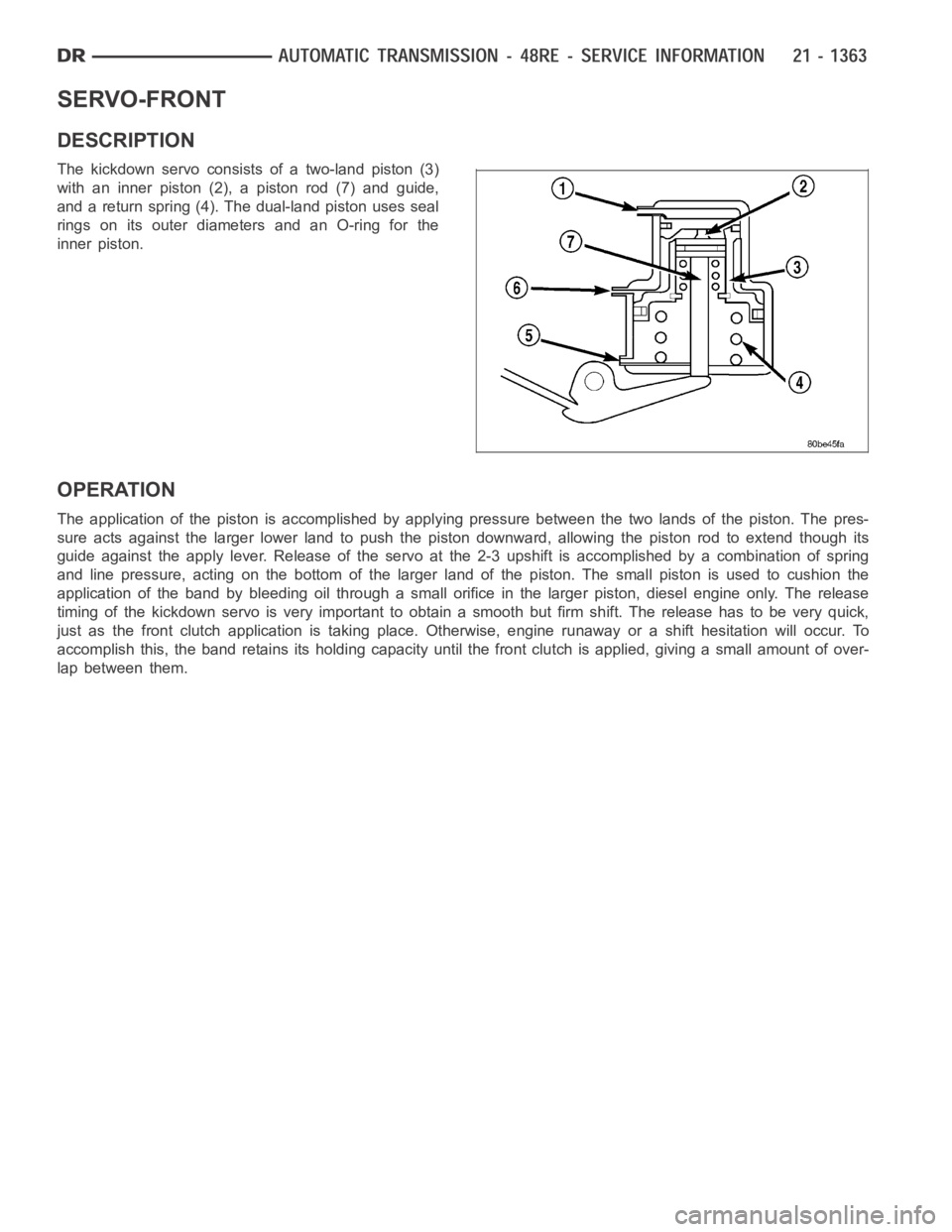
SERVO-FRONT
DESCRIPTION
The kickdown servo consists of a two-land piston (3)
with an inner piston (2), a piston rod (7) and guide,
and a return spring (4). The dual-land piston uses seal
rings on its outer diameters and an O-ring for the
inner piston.
OPERATION
The application of the piston is accomplished by applying pressure between the two lands of the piston. The pres-
sure acts against the larger lower land to push the piston downward, allowing the piston rod to extend though its
guide against the apply lever. Release of the servo at the 2-3 upshift is accomplished by a combination of spring
and line pressure, acting on the bottom of the larger land of the piston. Thesmallpistonisusedtocushionthe
application of the band by bleeding oil through a small orifice in the larger piston, diesel engine only. The release
timing of the kickdown servo is very important to obtain a smooth but firm shift. The release has to be very quick,
just as the front clutch application is taking place. Otherwise, engine runaway or a shift hesitation will occur. To
accomplish this, the band retains itsholding capacity until the front clutch is applied, giving a small amount of over-
lap between them.
Page 3890 of 5267
PUMP-OIL
DESCRIPTION
The oil pump is located in the pump housing inside the bell housing of the transmission case. The oil pump consists
of an inner gear (9), outer gear (10), a body (3), and a reaction shaft support(5).
OPERATION
As the torque converter rotates, the converter hub rotates the inner and outer gears. As the gears rotate, the clear-
ance between the gear teeth increases in the crescent area, and creates a suction at the inlet side of the pump.
This suction draws fluid through the pump inlet from the oil pan. As the clearance between the gear teeth in the
crescent area decreases, it forces pressurized fluid into the pump outletand to the valve body.
Oil Pump Assembly
1 - OIL SEAL 7 - BOLTS (6)
2 - VENT BAFFLE 8 - #1 THRUST WASHER (SELECTIVE)
3 - OIL PUMP BODY 9 - INNER GEAR
4 - GASKET 10 - OUTER GEAR
5 - REACTION SHAFT SUPPORT 11 - “O” RING
6 - SEAL RINGS 12 - TORQUE CONVERTER SEAL RING
Page 3891 of 5267
DISASSEMBLY
1. Mark position of support (2) in oil pump body (1)
for assembly alignment reference. Use scriber or
paint to make alignment marks.
2. Place pump body on two wood blocks.
3. Remove reaction shaft support bolts and separate
support (2) from pump body (1).
4. Remove pump inner (3) and outer gears (4).
Page 3892 of 5267

5. Remove o-ring seal (11) from pump body. Discard seal after removal.
6. Remove oil pump seal (1). Discard seal after removal.
CLEANING
Clean pump and support components with solvent and dry them with compressedair.
INSPECTION
Check condition of the seal rings and thrust washer on the reaction shaft support. The seal rings do not need to be
replaced unless cracked, broken, or severely worn.
Inspect the pump and support components. Replace the pump or support if theseal ring grooves or machined sur-
faces are worn, scored, pitted, or damaged. Replace the pump gears if pitted, worn chipped, or damaged.
Inspect the pump bushing. Then check the reaction shaft support bushing. Replace either bushing only if heavily
worn, scored or damaged. It is not necessary to replace the bushings unlessthey are actually damaged.
Oil Pump Assembly
1 - OIL SEAL 7 - BOLTS (6)
2 - VENT BAFFLE 8 - #1 THRUST WASHER (SELECTIVE)
3 - OIL PUMP BODY 9 - INNER GEAR
4 - GASKET 10 - OUTER GEAR
5 - REACTION SHAFT SUPPORT 11 - “O” RING
6 - SEAL RINGS 12 - TORQUE CONVERTER SEAL RING
Page 3894 of 5267
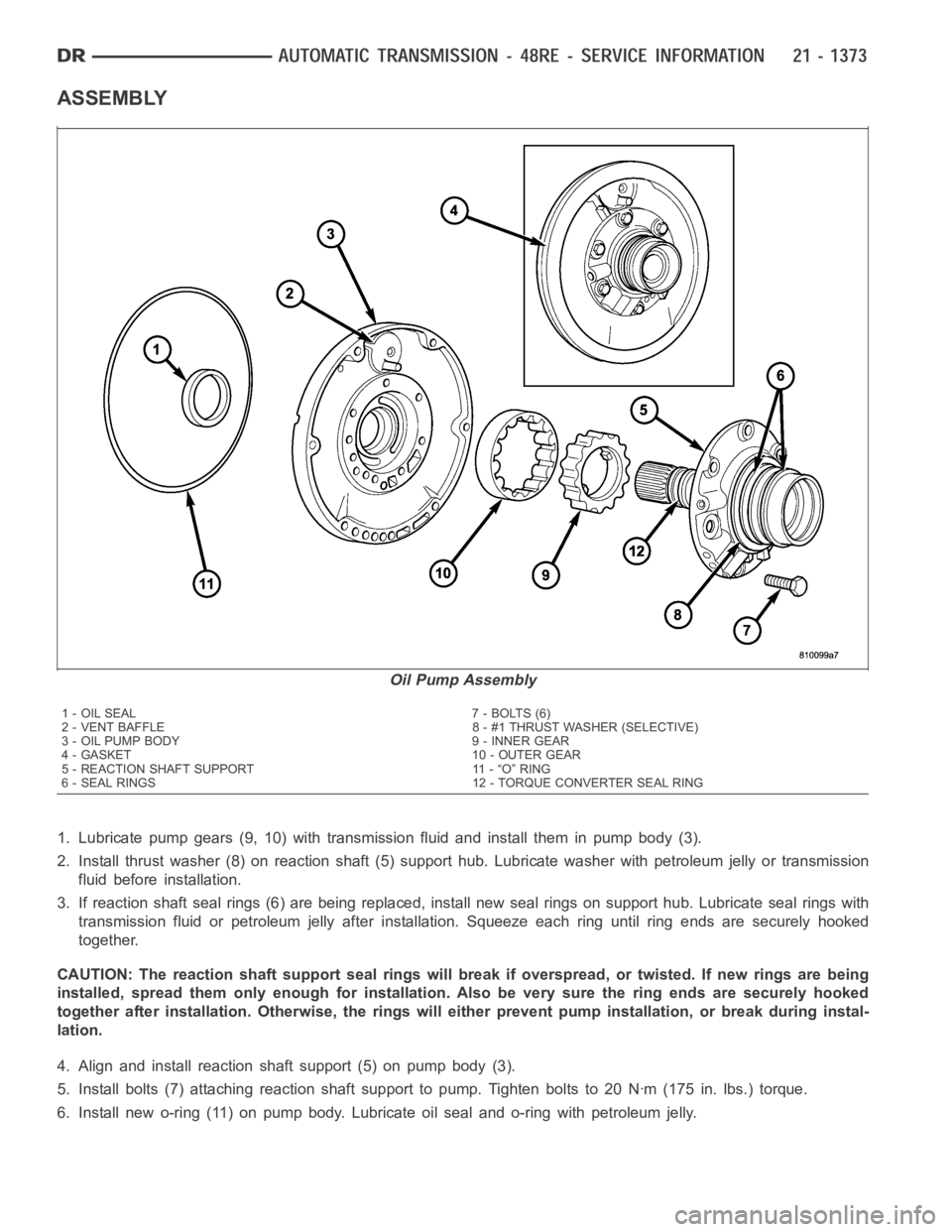
ASSEMBLY
1. Lubricate pump gears (9, 10) with transmission fluid and install them inpump body (3).
2. Install thrust washer (8) on reaction shaft (5) support hub. Lubricate washer with petroleum jelly or transmission
fluid before installation.
3. If reaction shaft seal rings (6) are being replaced, install new seal rings on support hub. Lubricate seal rings with
transmission fluid or petroleum jelly after installation. Squeeze each ring until ring ends are securely hooked
together.
CAUTION: The reaction shaft support seal rings will break if overspread, or twisted. If new rings are being
installed, spread them only enough forinstallation. Also be very sure thering ends are securely hooked
together after installation. Otherwise, the rings will either prevent pump installation, or break during instal-
lation.
4. Align and install reaction shaft support (5) on pump body (3).
5. Install bolts (7) attaching reaction shaft support to pump. Tighten bolts to 20 Nꞏm (175 in. lbs.) torque.
6. Install new o-ring (11) on pump body. Lubricate oil seal and o-ring with petroleum jelly.
Oil Pump Assembly
1 - OIL SEAL 7 - BOLTS (6)
2 - VENT BAFFLE 8 - #1 THRUST WASHER (SELECTIVE)
3 - OIL PUMP BODY 9 - INNER GEAR
4 - GASKET 10 - OUTER GEAR
5 - REACTION SHAFT SUPPORT 11 - “O” RING
6 - SEAL RINGS 12 - TORQUE CONVERTER SEAL RING
Page 3898 of 5267
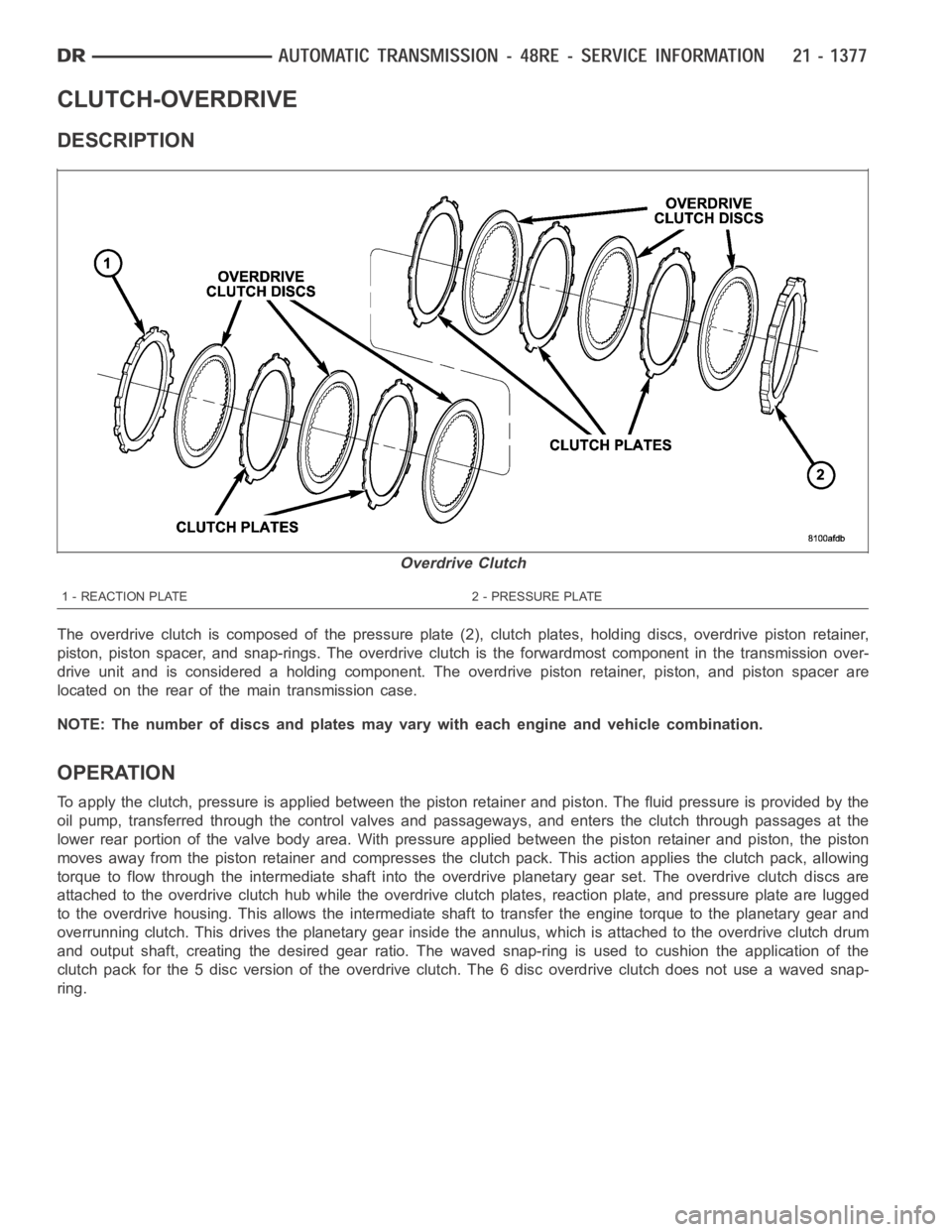
CLUTCH-OVERDRIVE
DESCRIPTION
The overdrive clutch is composed of the pressure plate (2), clutch plates,holding discs, overdrive piston retainer,
piston, piston spacer, and snap-rings. The overdrive clutch is the forwardmost component in the transmission over-
drive unit and is considered a holding component. The overdrive piston retainer, piston, and piston spacer are
located on the rear of the main transmission case.
NOTE: The number of discs and plates may vary with each engine and vehicle combination.
OPERATION
To apply the clutch, pressure is applied between the piston retainer and piston. The fluid pressure is provided by the
oil pump, transferred through the control valves and passageways, and enters the clutch through passages at the
lower rear portion of the valve body area. With pressure applied between the piston retainer and piston, the piston
moves away from the piston retainer and compresses the clutch pack. This action applies the clutch pack, allowing
torque to flow through the intermediate shaft into the overdrive planetary gear set. The overdrive clutch discs are
attached to the overdrive clutch hub while the overdrive clutch plates, reaction plate, and pressure plate are lugged
to the overdrive housing. This allows the intermediate shaft to transfer the engine torque to the planetary gear and
overrunning clutch. This drives the planetary gear inside the annulus, which is attached to the overdrive clutch drum
and output shaft, creating the desired gear ratio. The waved snap-ring is used to cushion the application of the
clutch pack for the 5 disc version of the overdrive clutch. The 6 disc overdrive clutch does not use a waved snap-
ring.
Overdrive Clutch
1 - REACTION PLATE 2 - PRESSURE PLATE
Page 3899 of 5267
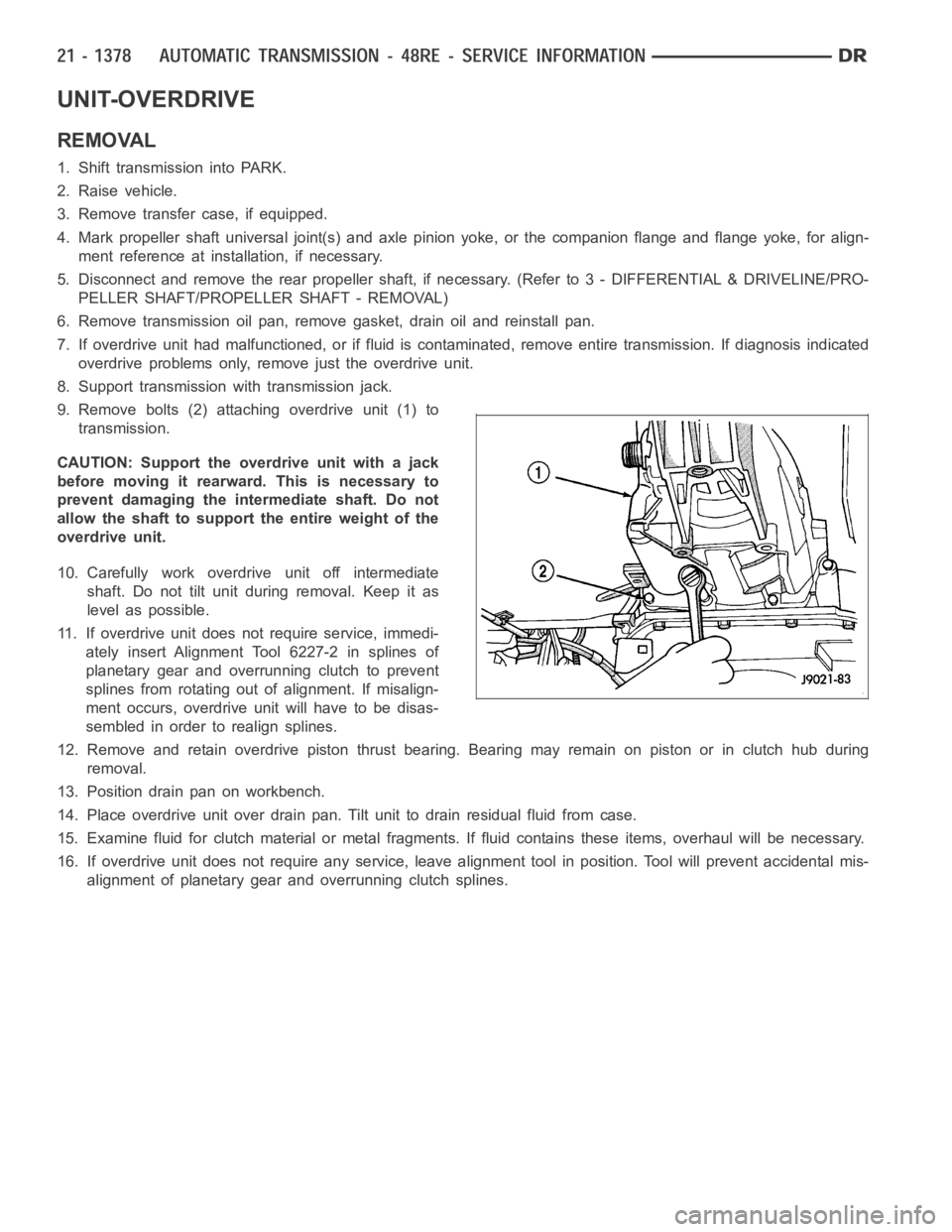
UNIT-OVERDRIVE
REMOVAL
1. Shift transmission into PARK.
2. Raise vehicle.
3. Remove transfer case, if equipped.
4. Mark propeller shaft universal joint(s) and axle pinion yoke, or the companion flange and flange yoke, for align-
ment reference at installation, if necessary.
5. Disconnect and remove the rear propeller shaft, if necessary. (Refer to3 - DIFFERENTIAL & DRIVELINE/PRO-
PELLER SHAFT/PROPELLER SHAFT - REMOVAL)
6. Remove transmission oil pan, remove gasket, drain oil and reinstall pan.
7. If overdrive unit had malfunctioned, or if fluid is contaminated, remove entire transmission. If diagnosis indicated
overdrive problems only, remove just the overdrive unit.
8. Support transmission with transmission jack.
9. Remove bolts (2) attaching overdrive unit (1) to
transmission.
CAUTION: Support the overdrive unit with a jack
before moving it rearward. This is necessary to
prevent damaging the intermediate shaft. Do not
allow the shaft to support the entire weight of the
overdrive unit.
10. Carefully work overdrive unit off intermediate
shaft. Do not tilt unit during removal. Keep it as
level as possible.
11. If overdrive unit does not require service, immedi-
ately insert Alignment Tool 6227-2 in splines of
planetary gear and overrunning clutch to prevent
splines from rotating out of alignment. If misalign-
ment occurs, overdrive unit will have to be disas-
sembled in order to realign splines.
12. Remove and retain overdrive piston thrust bearing. Bearing may remainon piston or in clutch hub during
removal.
13. Position drain pan on workbench.
14. Place overdrive unit over drain pan. Tilt unit to drain residual fluid from case.
15. Examine fluid for clutch material or metal fragments. If fluid contains these items, overhaul will be necessary.
16. If overdrive unit does not require any service, leave alignment tool inposition. Tool will prevent accidental mis-
alignment of planetary gear and overrunning clutch splines.